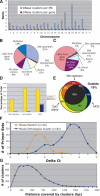Genome-wide mapping of DNase hypersensitive sites using massively parallel signature sequencing (MPSS)
- PMID: 16344561
- PMCID: PMC1356136
- DOI: 10.1101/gr.4074106
Genome-wide mapping of DNase hypersensitive sites using massively parallel signature sequencing (MPSS)
Abstract
A major goal in genomics is to understand how genes are regulated in different tissues, stages of development, diseases, and species. Mapping DNase I hypersensitive (HS) sites within nuclear chromatin is a powerful and well-established method of identifying many different types of regulatory elements, but in the past it has been limited to analysis of single loci. We have recently described a protocol to generate a genome-wide library of DNase HS sites. Here, we report high-throughput analysis, using massively parallel signature sequencing (MPSS), of 230,000 tags from a DNase library generated from quiescent human CD4+ T cells. Of the tags that uniquely map to the genome, we identified 14,190 clusters of sequences that group within close proximity to each other. By using a real-time PCR strategy, we determined that the majority of these clusters represent valid DNase HS sites. Approximately 80% of these DNase HS sites uniquely map within one or more annotated regions of the genome believed to contain regulatory elements, including regions 2 kb upstream of genes, CpG islands, and highly conserved sequences. Most DNase HS sites identified in CD4+ T cells are also HS in CD8+ T cells, B cells, hepatocytes, human umbilical vein endothelial cells (HUVECs), and HeLa cells. However, approximately 10% of the DNase HS sites are lymphocyte specific, indicating that this procedure can identify gene regulatory elements that control cell type specificity. This strategy, which can be applied to any cell line or tissue, will enable a better understanding of how chromatin structure dictates cell function and fate.
Figures






References
-
- Barnett, V. and Lewis, T. 1998. Outliers in statistical data. John Wiley and Sons, West Sussex, UK.
-
- Brenner, S., Johnson, M., Bridgham, J., Golda, G., Lloyd, D.H., Johnson, D., Luo, S., McCurdy, S., Foy, M., Ewan, M., et al. 2000. Gene expression analysis by massively parallel signature sequencing (MPSS) on microbead arrays. Nat. Biotechnol. 18: 630-634. - PubMed
-
- Collins, F.S., Green, E.D., Guttmacher, A.E., and Guyer, M.S. 2003. A vision for the future of genomics research. Nature 422: 835-847. - PubMed
-
- Crawford, G.E., Holt, I.E., Mullikin, J.C., Tai, D., National Institutes of Health Intramural Sequencing, Blakesley, R., Bouffard, G., Young, A., Masiello, C., Green, E.D., et al. 2004. Identifying gene regulatory elements by genome-wide recovery of DNase hypersensitive sites. Proc. Natl. Acad. Sci. 101: 992-997. - PMC - PubMed
-
- The Encode Consortium. 2004. The ENCODE (Encyclopedia of DNA Elements) Project. Science 306: 636-640. - PubMed
Web site references
-
- http://genome.ucsc.edu/ENCODE/; UCSC genome browser for ENCODE regions
-
- http://genome.ucsc.edu/; UCSC genome browser
-
- http://www.ncbi.nlm.nih.gov/geo; Gene Expression Omnibus
-
- http://www.bioconductor.org; Bioconductor
-
- http://research.nhgri.nih.gov/DNaseHS/; List of DNase HS sites described in this paper
Publication types
MeSH terms
Substances
Grants and funding
LinkOut - more resources
Full Text Sources
Other Literature Sources
Research Materials
Miscellaneous
